I tried meatball recipes from Ina Garten, Ree Drummond, and Guy Fieri, and the best would be perfect for a holiday gathering
Kate Ng

- I tried meatball recipes from Ina Garten, Ree Drummond, and Guy Fieri to see which was best.
- Fieri's was simple, with few ingredients, and Garten's meatballs surprisingly lacked flavor.
Meatballs are a handy staple I like to whip out whenever I want something that's not too difficult to prepare but still impressive for my audience (aka usually just my husband and myself).
Plus, they're a great appetizer to quickly throw together for holiday gatherings.
On the hunt for tasty, tender meatballs that would lend themselves well to nearly any sauce, I tested recipes from Ina Garten, Ree Drummond, and Guy Fieri.
Here's how they stacked up.
Fieri's recipe had the shortest ingredient list.
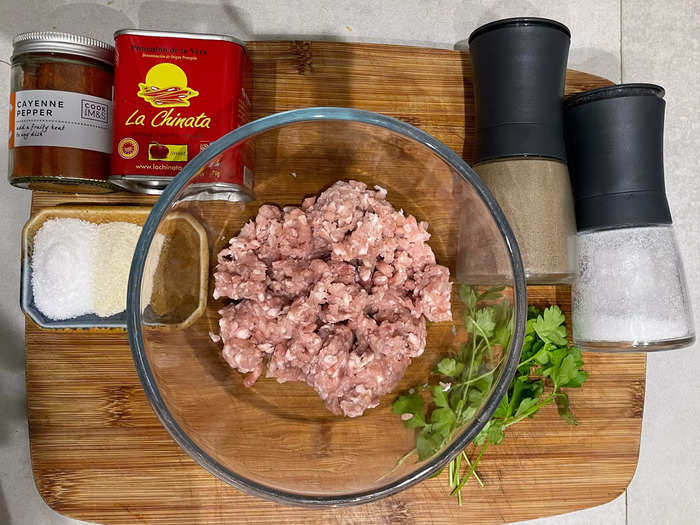
I know Fieri loves spice, so I wasn't surprised to see smoked paprika, ground cumin, and cayenne pepper on his ingredient list alongside granulated garlic and onion powder.
His recipe also called for ground pork, fresh parsley, salt, and pepper.
To my surprise, it didn't require any sort of liquid, like milk or eggs, which raised suspicions that these meatballs would be rather dry.
I placed all the spices in a bowl with the ground pork.
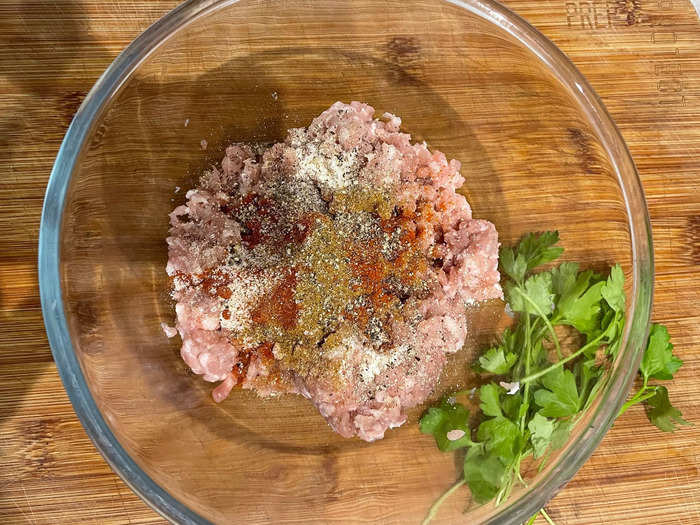
I measured out the various spices and seasonings and added them to a mixing bowl with the ground pork, combining everything with a fork.
But I quickly realized the easiest way to ensure all the spices were distributed evenly throughout the meat would be to mix it by hand.
I recommend popping on some thin gloves as the paprika and cayenne pepper can stain bare skin.
I rolled the mixture into 2-ounce balls.
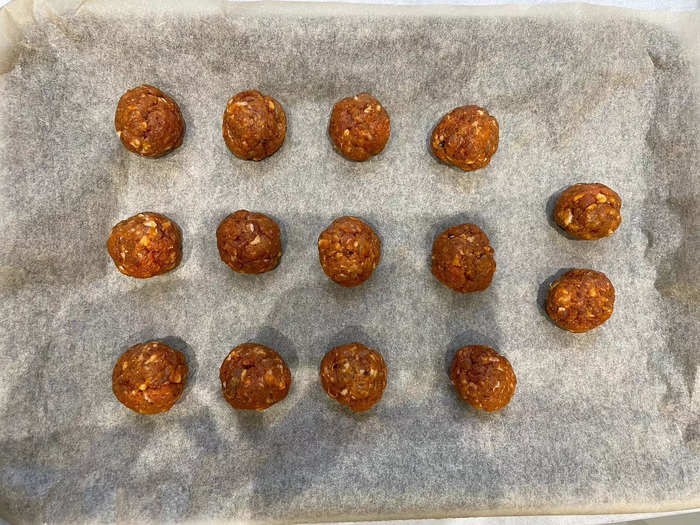
I began pinching small amounts of the meat mixture and weighing them into 2-ounce portions. Then I rolled them into balls and arranged them on a tray lined with baking paper.
While I did this, I turned on the oven to let it preheat to 350 degrees Fahrenheit.
Once all the meatballs were prepared, I popped them straight into the preheated oven for 12 minutes. Fieri's recipe recommended 10 to 15 minutes, so I decided on a middle ground.
The cooked meatballs turned out perfectly browned.
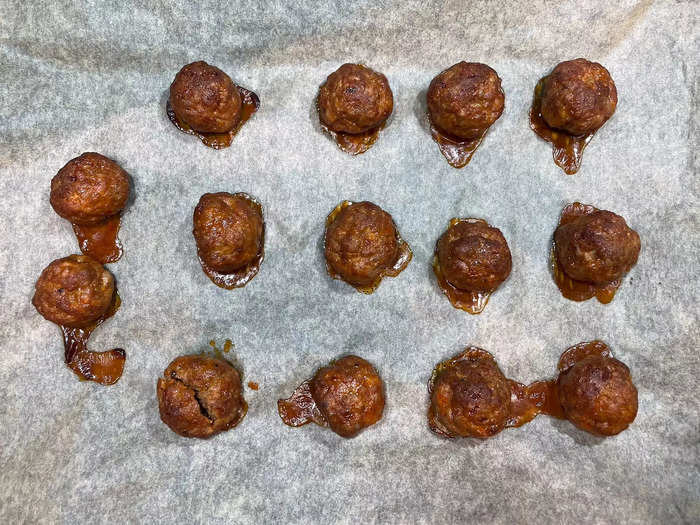
The meatballs filled my kitchen with the pleasant aroma of spices.
Because there was so little fat in the recipe, there also wasn't a lot of grease. But that meant these meatballs were quite hard and dry.
I enjoyed the flavors of the spices, but I think they definitely need a sauce.
I moved on to Drummond's meatball recipe.
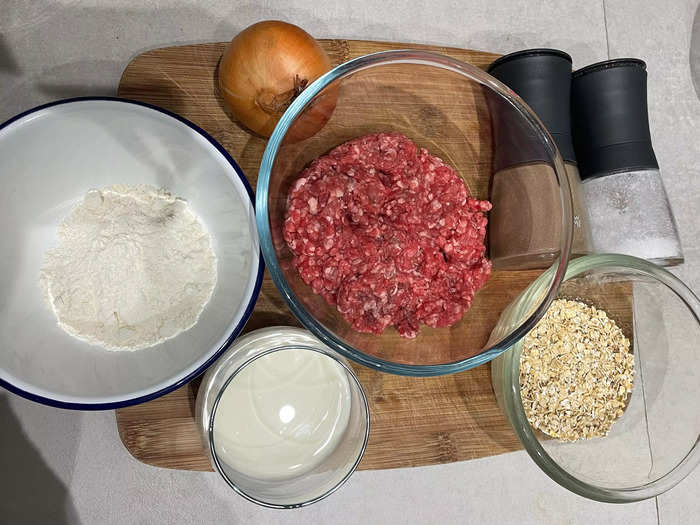
Drummond's recipe had just a few more ingredients than Fieri's, but it involved fewer spices.
The addition of oats to bind the mixture, milk for moisture, and minced onions for flavor made it feel more like a classic meatball recipe.
Drummond calls for ground beef, but my local butcher had ground chuck, which has a higher fat content than ground beef. I was aware that my meatballs might turn out slightly greasier than the chef's, but I didn't mind.
Her recipe also included flour and oil for dredging and frying later on, as well as more onions, ketchup, white vinegar, Worcestershire sauce, hot sauce, and sugar for a sauce.
I minced the onions as finely as possible.
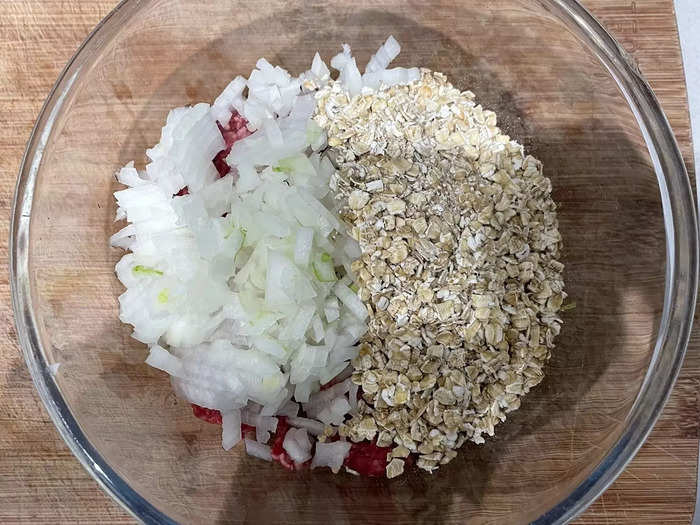
Drummond specifically called for "very finely minced onions," which I struggled to cut. I did my best to chop the onions up small.
Aside from measuring out all the other ingredients, mincing the onion was the only prep required. I put everything in a mixing bowl with the ground beef before realizing I was meant to mix the beef and oats before adding everything else.
I figured it would be fine as everything gets mixed together anyway, so I continued with the recipe.
The meat mixture was a little looser because of the additional liquid.
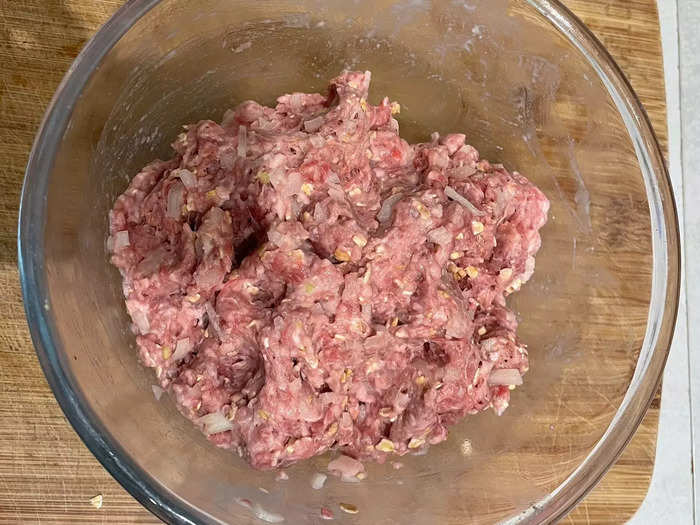
After mixing all the ingredients, I noticed how much looser the mixture felt compared to Fieri's. But it didn't seem too wet to roll into tablespoon-sized balls.
Once they were rolled out and arranged on a baking sheet, I covered them and let them firm up in the fridge.
I dredged the meatballs in flour before frying them.
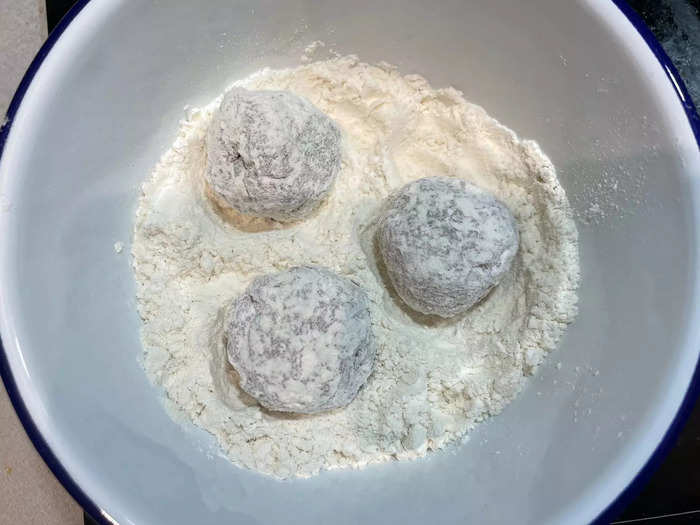
I heated some oil in a heavy-bottomed skillet and dredged three or four meatballs in the flour while waiting for it to heat up.
While the meatballs were frying, I preheated the oven to 350 F.
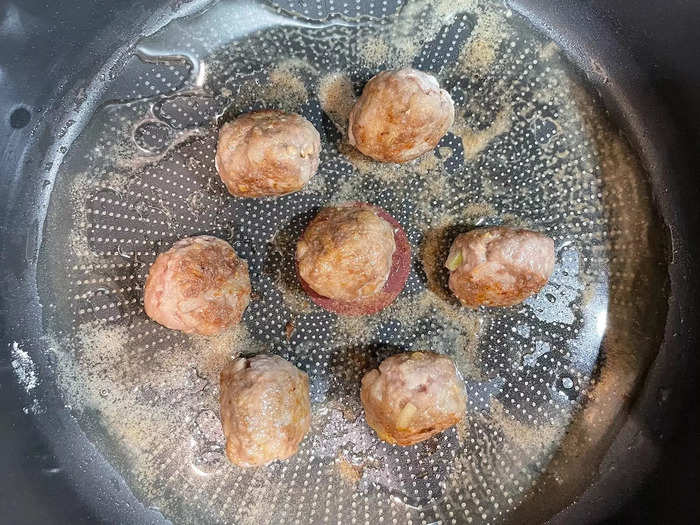
Once the oil was hot, I added the flour-coated meatballs and let them sizzle, turning them over until they were light brown all over.
While my oven preheated to 350 F, I removed the browned meatballs from the heat and arranged them on a rectangular baking dish.
Before digging in, I made an onion-and-ketchup sauce.
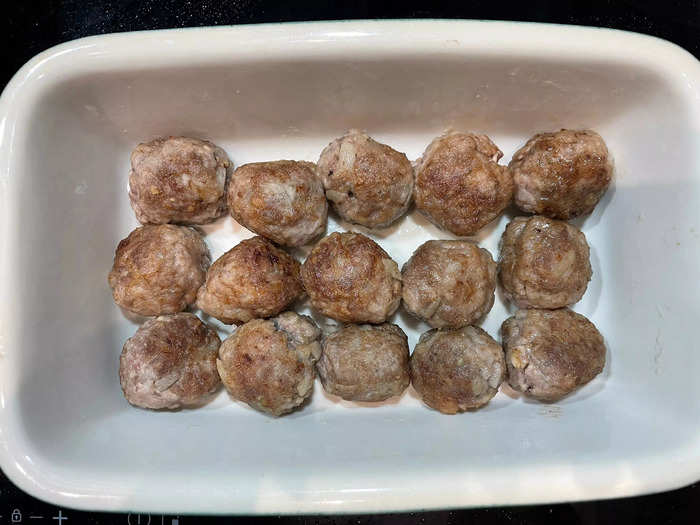
Once all the meatballs were browned and in the baking dish, I turned to Drummond's sauce recipe.
I minced more onions and mixed them in a bowl with ketchup, white vinegar, sugar, Worcestershire sauce, and a couple of dashes of hot sauce.
I poured the sauce mixture all over the top of the meatballs, ensuring they were covered, and placed them in the oven for 40 minutes. The chef recommended 45, but mine were done quicker.
The meatballs turned out springy and full of flavor.
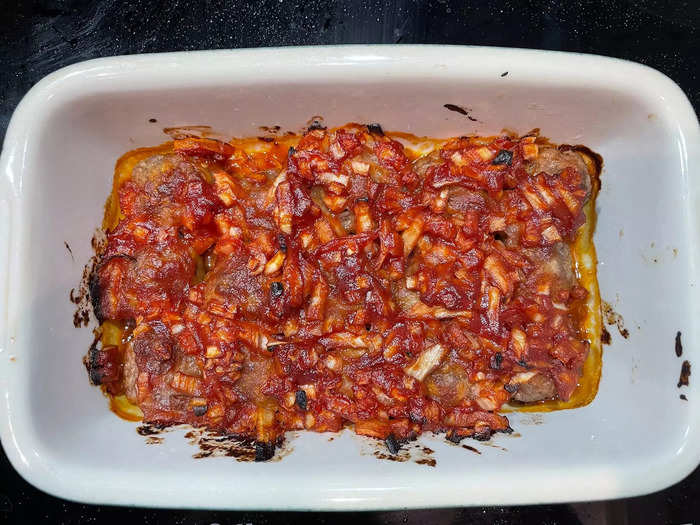
When I first opened the oven to remove the meatballs, I was hit by the acidic smell of the white vinegar, which was slightly unappealing.
But this quickly dissipated and the resulting dish was very tasty. I was impressed by how moist and tender the meatballs were, and I enjoyed the extra flavor that came from browning them first.
The tangy sauce was also a good complement to the meatballs.
Lastly, I got started on Garten's recipe.

Garten's recipe had the longest ingredient list, including three types of meat: ground pork, ground sirloin, and ground veal.
She also called for fresh Italian pecorino cheese, fresh Italian Parmesan, bread crumbs, minced garlic, fresh parsley, and pepper.
In terms of wet ingredients, the recipe included water, two extra-large eggs (lightly beaten), and ¾ cup of dry red wine (I went with Rosso).
I set about mincing and grating.
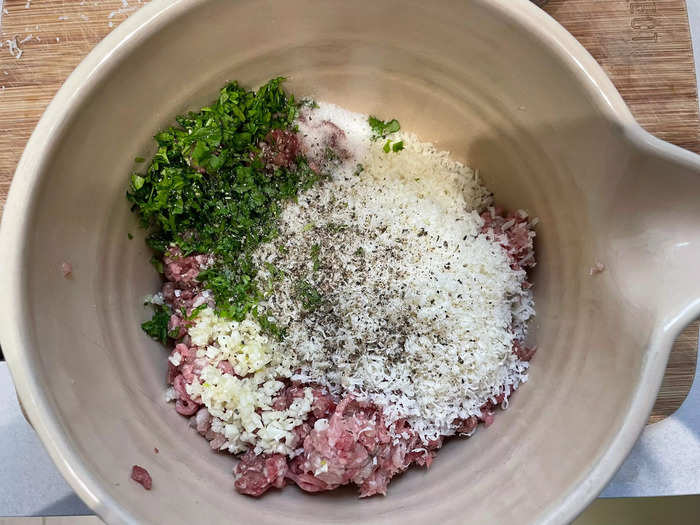
Garten's recipe required the most prep. I grated both cheeses, minced the garlic and parsley, and measured out the bread crumbs.
Then I added all three ground meats into a large bowl and mixed them together before adding the dry ingredients.
Once everything was thoroughly mixed, I poured in the red wine, eggs, and ¾ cup of water.
The mixture smelled strongly of garlic and wine.
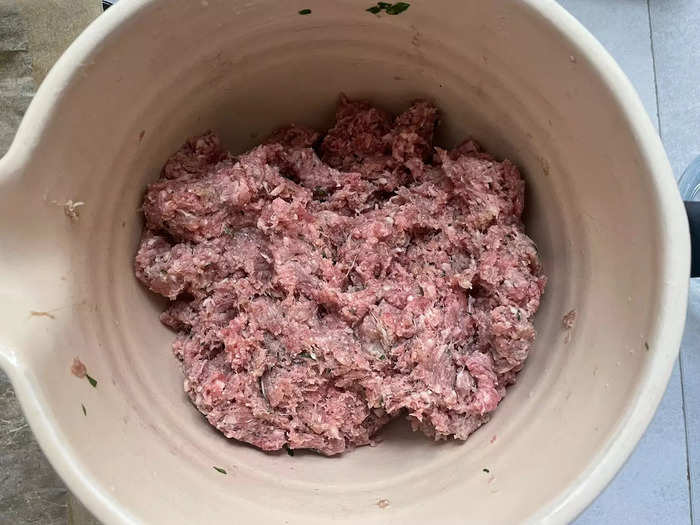
After combining all the ingredients, I began rolling the mixture into 2-ounce portions.
I arranged the balls on baking sheets and brushed each with olive oil, as Garten instructed.
Once my oven was preheated to 400 F, I popped the meatballs in and baked them for 30 minutes.
The recipe said between 25 to 30 minutes, but I chose the top end to ensure the different meats were cooked all the way through.
The cooked meatballs produced more grease than I expected.
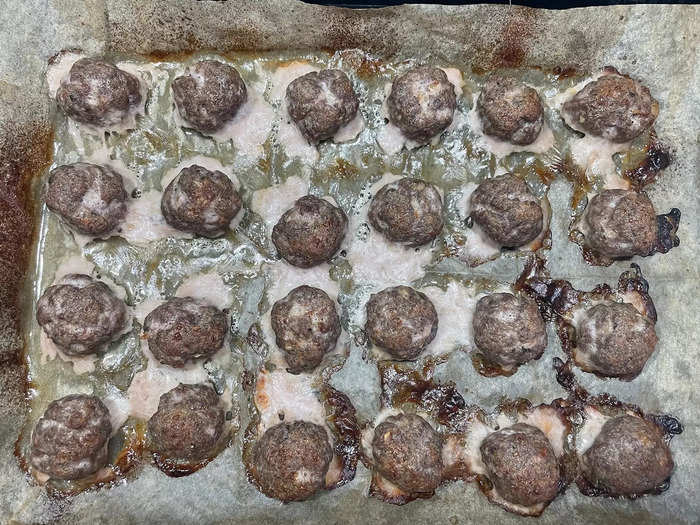
When I pulled the meatballs out, I noticed most of them were surrounded by pools of grease.
They also smelled very strongly of cheese, which I would normally enjoy. But in this instance, it was slightly off-putting for some reason.
Garten's meatballs were tasty but slightly dry.
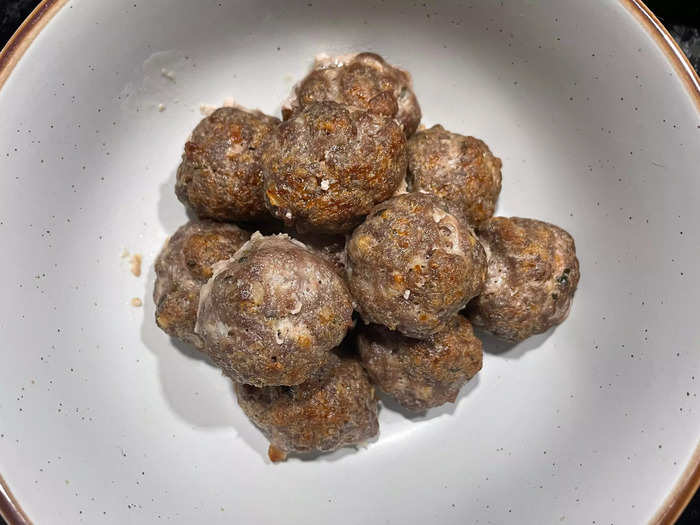
The meatballs were well-seasoned, thanks to all the salt in the cheeses. But I was surprised to find that they were kind of dry.
I was sure all the liquid from the eggs, wine, and water would make them moist. Maybe the liquid escaped from the meat with the grease during the cooking process.
Still, in a tomato sauce with spaghetti or polenta, I think these meatballs would be quite delicious.
All three meatball recipes were very different, but I enjoyed Drummond's the most.
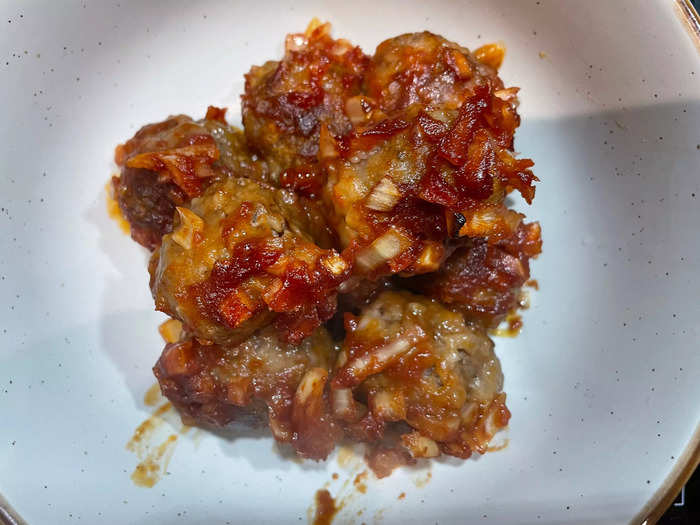
Drummond's recipe was the most classic and produced really delicious meatballs with good textures and flavors.
I kept a few to try with a different sauce and they worked just as well, so they're also quite versatile.
Garten's was a more adventurous recipe. But it included a lot of expensive ingredients and didn't yield results that have me dying to make it again.
Fieri's meatballs were very tasty, but they needed a sauce to help the texture. Given the short ingredient list though, they were probably the easiest to make.
Click to check out the other celebrity-chef recipes we've put head-to-head so far.
Popular Right Now
Popular Keywords
Advertisement